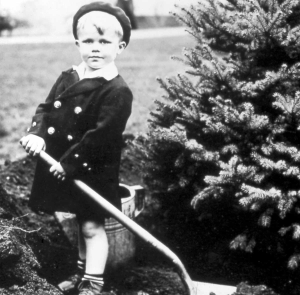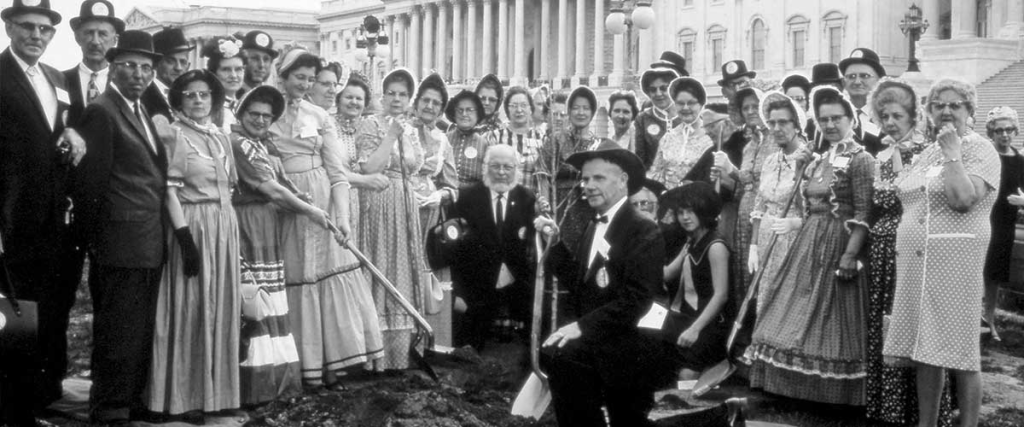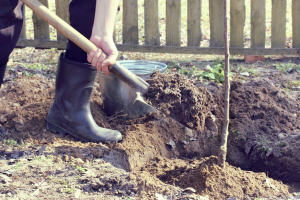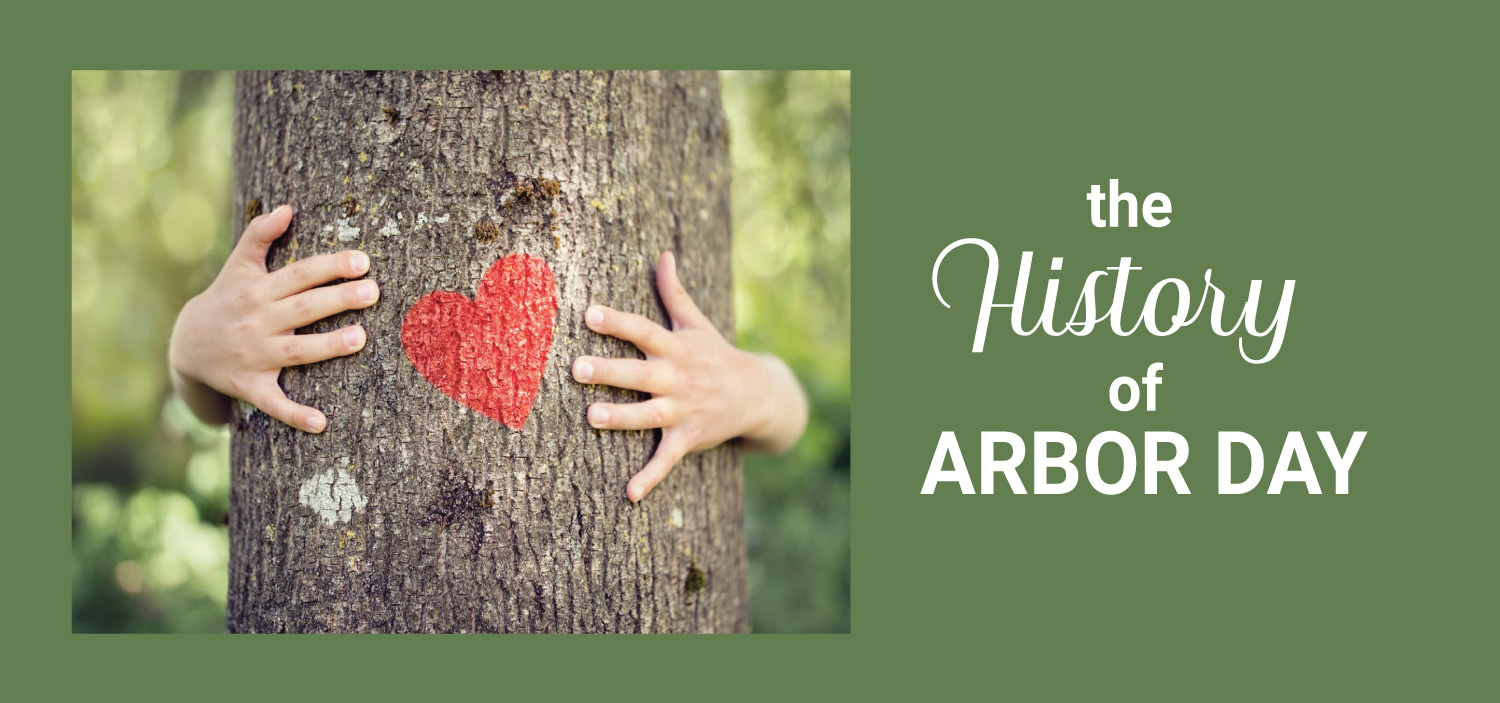The History of Arbor Day
April 6, 2022 As pioneers began moving into the Nebraska Territory, the lack of trees was felt deeply. Not only did the new residents miss the trees they left behind, they were also left without the trees they needed as windbreaks to keep soil in place, for fuel and building materials, and for shade from the hot sun. Nebraska newspaper editor — and resident of Nebraska City, NE — J. Sterling Morton had an enthusiasm for trees and advocated strongly for individuals and civic groups to plant them. Once he became secretary of the Nebraska Territory, he further spread his message of the value of trees. And on January 4, 1872, Morton first proposed a tree planting holiday to be called “Arbor Day” at a meeting of the State Board of Agriculture.
As pioneers began moving into the Nebraska Territory, the lack of trees was felt deeply. Not only did the new residents miss the trees they left behind, they were also left without the trees they needed as windbreaks to keep soil in place, for fuel and building materials, and for shade from the hot sun. Nebraska newspaper editor — and resident of Nebraska City, NE — J. Sterling Morton had an enthusiasm for trees and advocated strongly for individuals and civic groups to plant them. Once he became secretary of the Nebraska Territory, he further spread his message of the value of trees. And on January 4, 1872, Morton first proposed a tree planting holiday to be called “Arbor Day” at a meeting of the State Board of Agriculture.
The celebration date was set for April 10, 1872. Prizes were offered to counties and individuals for the largest number of properly planted trees on that day. It was estimated that more than 1 million trees were planted in Nebraska on the first Arbor Day.

Arbor Day was officially proclaimed in 1874 by Nebraska’s Governor, Robert W. Furnas, and the day was observed April 10 that year. In 1885, Arbor Day was named a legal state holiday in Nebraska, and April 22 was selected as the date for its permanent annual observance.
A Greener Future for Everyone
We plant trees because people need trees. And when planted in the right place, they have great impact. Trees help slow climate change, filter our air and water, foster biodiversity, and strengthen our communities. They create the kind of transformational change the world needs now.
With your help, we can plant trees today for a better tomorrow.
Tree Facts
What can a tree do for you? A lot. Check out all the ways—sometimes unexpected—that trees positively affect us, our communities, and our world.
Trees help clean our air.
1. Global forests removed about one-third of fossil fuel emissions annually from 1990 to 2007.
2. Trees remove pollution from the atmosphere, improving air quality and human health.
• In Los Angeles, trees remove nearly 2,000 tons of air pollution each year.
• In Chicago, trees remove more than 18,000 tons of air pollution each year.
• In Greater Kansas City, trees remove 26,000 tons of air pollution each year.
3. Roadside trees reduce nearby indoor air pollution by more than 50%.
Trees contribute to our health.
4. A study of 10 cities found community forests save an average of one life each year. In New York City, trees save an average of eight lives every year.
5. Office workers with a view of trees report significantly less stress and more satisfaction.
Trees provide us with oxygen.
6. One large tree can provide a day’s supply of oxygen for up to four people.
7. More than 20% of the world’s oxygen is produced in the Amazon Rainforest
Trees help clean our drinking water.
8. Forested watersheds provide quality drinking water to more than 180 million Americans.
9. In 1997, New York City spent $1.5 billion to preserve the forested watershed that supplies New York City’s drinking water by purchasing thousands of upstate acres of forested watershed. A filtration plant large enough to clean New York City’s water supply would have cost more than $6 billion dollars.
• Today, New Yorkers enjoy some of the cleanest drinking water in the world, and New York City has won regional water taste competitions.
Trees provide much-needed cooling.
10. Trees lower surface and air temperatures by providing shade. Shaded surfaces may be 20–45°F cooler than the peak temperatures of unshaded materials.
• Trees cool the city by up to 10°F by shading our homes and streets and releasing water vapor into the air through their leaves.
11. Evaporation of water from trees has a cooling influence.
Trees help reduce the effects of climate change.
12. Trees absorb carbon dioxide (CO2), removing and storing the carbon while releasing the oxygen back into the air.
• In one year, an acre of mature trees absorbs the amount of CO2 produced by a car driven 26,000 miles.
13. During one year, a mature tree will absorb more than 48 pounds of carbon dioxide from the atmosphere and release oxygen in exchange.
• Nearly 20 pounds of carbon dioxide are produced from burning one gallon of non-ethanol gasoline.
Trees help us save energy.
14. Trees properly placed around buildings can reduce air conditioning needs by 30% and can save 20–50% in energy used for heating.
• The average Cincinnati community tree saves the average household $56 annually in cooling costs by reducing electricity use. More than 85,000 Cincinnati community trees save residents $4.8 million.
15. Carefully positioned trees can reduce a household’s energy consumption for heating and cooling by up to 25%. Computer models devised by the U.S. Department of Energy predict that the proper placement of only three trees can save an average household between $100 and $250 in energy costs annually.
Trees benefit wildlife.
16. Trees provide vital wildlife habitat.
• In British Columbia, Canada, more than 80 wildlife species depend on trees.
17. Trees and forests provide important species range. Many animals have a range of hundreds of square miles. The mountain lion of North America, for instance, has a range of nearly 400 square miles.
Trees help reduce crime.
18. In Baltimore, a 10% increase in tree canopy corresponded to a 12% decrease in crime.
19. Among minor crimes, there is less graffiti, vandalism and littering in outdoor spaces with trees as a part of the natural landscape than in comparable plant-less spaces.
20. Chicago public housing residents with nearby trees and natural landscapes reported 25% fewer acts of domestic aggression and violence.
Trees are a good investment of our public dollars
21. Every dollar spent on planting and caring for a community tree yields benefits that are two to five times that investment—benefits that include cleaner air, lower energy costs, improved water quality and storm water control and increased property values.
• In Indianapolis, each dollar invested in the city’s community trees yielded $5.55 in benefits.
• In New York City, it has been calculated that community trees provide $5.60 in benefits for every dollar spent on tree planting and care.
• In Cincinnati, the return on a $1 investment in the city’s community trees is $4.44.
22. The mature street trees in Beverly Hills, California, are worth $450 million.
23. A cost-benefit analysis of the Berkeley, California, tree canopy indicated that each Camphor tree had an annual net benefit to the city and its residents of nearly $12,500, each Shamel Ash showed a $9,600 annual net benefit, and each London Plane tree had an annual net benefit of more than $8,700 per tree.
Trees increase our property values.
24. In Portland, Oregon, homes with street trees sold for $7,130 more, on average, and 1.7 days more quickly.
• Neighboring houses within 100 feet of street trees sold for $1,688 more, on average.
• The sale premium of having street trees was the same as adding 129 square feet of finished space.
25. In Fulton County (Atlanta), Georgia, mature trees positively influenced home sale prices. Homes sold for nearly $105,000 more in neighborhoods with mature trees.
What Can You Do to Celebrate?
Plant a tree
Whether you plant your tree for shade, flowers, fruit, or wildlife habitat, be sure to choose the right tree for the location.
Learn how to properly plant and care for it. But don’t just plant the tree. Consider the ways that the tree could mean even more for your family. Create a dedication plaque to commemorate a special person or life event — like the birth of a child, start of a business, purchase of a home, or as a memorial for a lost loved one.
Be an influencer for trees
Use the digital world as a force for good by sharing your tree planting and other Arbor Day activities on social media. Tag people and brands who are in your post to be seen by them and their followers. (Don’t spam people who aren’t actually in the post). Use the hashtags #ArborDay, #trees, #planttrees, and #forests to expand your reach and be seen by others who use and follow those hashtags.
Read a book about trees
Learning is a vital part of conservation, and there is always more to find out. If you are new to the trees in your area, find a book about tree identification. Not sure how photosynthesis or annual growth rings work? There are books that can help. Peter Wohlleben’s “The Hidden Life of Trees” offers a fascinating introduction to the ways that trees interact with one another and the larger environment. Kids will love classic titles like “The Giving Tree,” by Shel Silverstein, or “The Lorax,” by Dr. Seuss.
Write a tree story or create tree art
Trees have always played important roles in storytelling and art. Their sheer size and extended life span serve as symbols of life and growth, longevity, prosperity, power, and wisdom. The extensive but hidden root system calls to mind mystery and solidity. The diversity of forms, from the mournful weeping willow to the rugged cliffside juniper, evoke the full range of emotions. Let your imagination run wild.
Volunteer with a tree-planting organization
Planting trees is a great way to build relationships. Local community groups in your area may already be planning an Arbor Day event that your family can join. They may have a special interest in preserving threatened species, providing wildlife habitat, feeding the hungry, or beautifying the neighborhood. It’s an excellent way to get involved, do good, learn, and get to know your neighbors.

